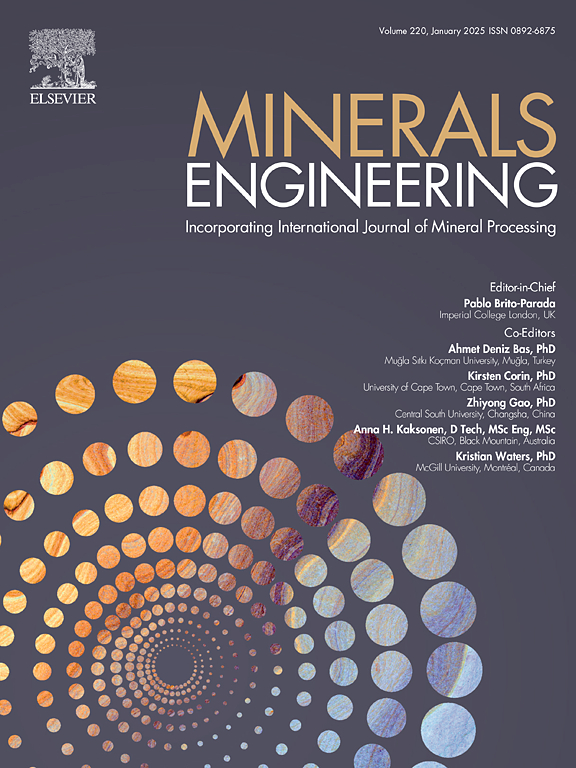机器学习驱动的煤泥浮选协同复合药剂智能筛选系统
IF 4.9
2区 工程技术
Q1 ENGINEERING, CHEMICAL
引用次数: 0
摘要
针对煤泥浮选复合捕收剂筛选效率低、作用机理复杂的技术瓶颈,提出了一种基于机器学习的复合药剂智能筛选方法。该方法通过构建950个实验组的数据集,将XGBoost集成算法与可解释性分析工具相结合,实现了对浮选性能的高精度预测(训练集MAE = 0.4592,验证集MAE = 0.4923,测试集MAE = 0.5268)。SHAP特征重要性分析表明,药剂类型对可燃采收率的影响最为显著,药剂混合比对模型预测也有一定的调节作用。基于SHAP相互作用值的进一步分析表明,在特定的混合比例下,某些捕集剂组合表现出协同增强效应,表明该模型可以有效识别和解耦混合试剂体系中的非线性耦合行为。在机理层面,提出了“吸附-互补模型”和“分子组装效应模型”来阐明协同机理:极性组分通过氢键选择性地锚定煤表面亲水位点,非极性组分沿分子骨架自组装形成界面疏水结构,从而协同增强整体疏水性。双向预测框架将正向性能预测与基于目标函数的试剂配方反向优化相结合,通过可解释性分析实现复方方案的可控设计。与传统的试错法相比,该策略显著减少了实验工作量,大大提高了复合捕收器的筛选效率。该方法克服了经验和昂贵的传统设计方法的局限性,为复杂煤泥系统的智能收集器优化提供了数据驱动的范例。结果表明,该模型在单煤条件下具有良好的泛化能力;然而,试剂之间的微观相互作用机制需要进一步验证,其在不同煤类型中的适用性仍然有限。未来的工作可能涉及多源浮选数据的集成,以加强药剂系统建模,促进智能选矿技术的发展。本文章由计算机程序翻译,如有差异,请以英文原文为准。

Machine learning-driven intelligent screening system for synergistic compound reagent in coal slime flotation
To address the technical bottlenecks of low screening efficiency and complex action mechanisms in the design of compound collectors for coal slime flotation, this study proposes a machine learning-based intelligent screening method for compound reagents. By constructing a dataset comprising 950 experimental groups and integrating the XGBoost ensemble algorithm with interpretability analysis tools, the method achieves high-accuracy prediction of flotation performance (training set MAE = 0.4592, validation set MAE = 0.4923, testing set MAE = 0.5268). SHAP feature importance analysis indicates that reagent type has the most significant impact on combustible recovery, while reagent mixing ratios also modulate model predictions to a certain extent. Further analysis based on SHAP interaction values reveals that certain collector combinations exhibit synergistic enhancement effects at specific mixing ratios, indicating that the model can effectively identify and decouple nonlinear coupling behaviors within mixed reagent systems. At the mechanistic level, the “adsorption-complementarity model” and “molecular assembly effect model” are proposed to elucidate the cooperative mechanisms: polar components selectively anchor hydrophilic sites on coal surfaces via hydrogen bonding, while non-polar components self-assemble along molecular backbones to form interfacial hydrophobic structures, thereby synergistically enhancing overall hydrophobicity. The bidirectional prediction framework integrates forward performance prediction with reverse optimization of reagent formulations based on target functions, enabling controllable design of compound schemes through interpretability analysis. Compared with traditional trial-and-error methods, this strategy significantly reduces experimental workload and greatly improves the screening efficiency of compound collectors. This approach overcomes the limitations of empirical and costly traditional design methods, providing a data-driven paradigm for intelligent collector optimization in complex coal slime systems. The results indicate that the model exhibits good generalization ability under single-coal conditions; however, the microscopic interaction mechanisms among reagents require further validation, and its applicability across different coal types remains limited. Future work may involve the integration of multi-source flotation data to enhance reagent system modeling and promote the development of intelligent mineral processing technologies.
求助全文
通过发布文献求助,成功后即可免费获取论文全文。
去求助
来源期刊

Minerals Engineering
工程技术-工程:化工
CiteScore
8.70
自引率
18.80%
发文量
519
审稿时长
81 days
期刊介绍:
The purpose of the journal is to provide for the rapid publication of topical papers featuring the latest developments in the allied fields of mineral processing and extractive metallurgy. Its wide ranging coverage of research and practical (operating) topics includes physical separation methods, such as comminution, flotation concentration and dewatering, chemical methods such as bio-, hydro-, and electro-metallurgy, analytical techniques, process control, simulation and instrumentation, and mineralogical aspects of processing. Environmental issues, particularly those pertaining to sustainable development, will also be strongly covered.
 求助内容:
求助内容: 应助结果提醒方式:
应助结果提醒方式:


